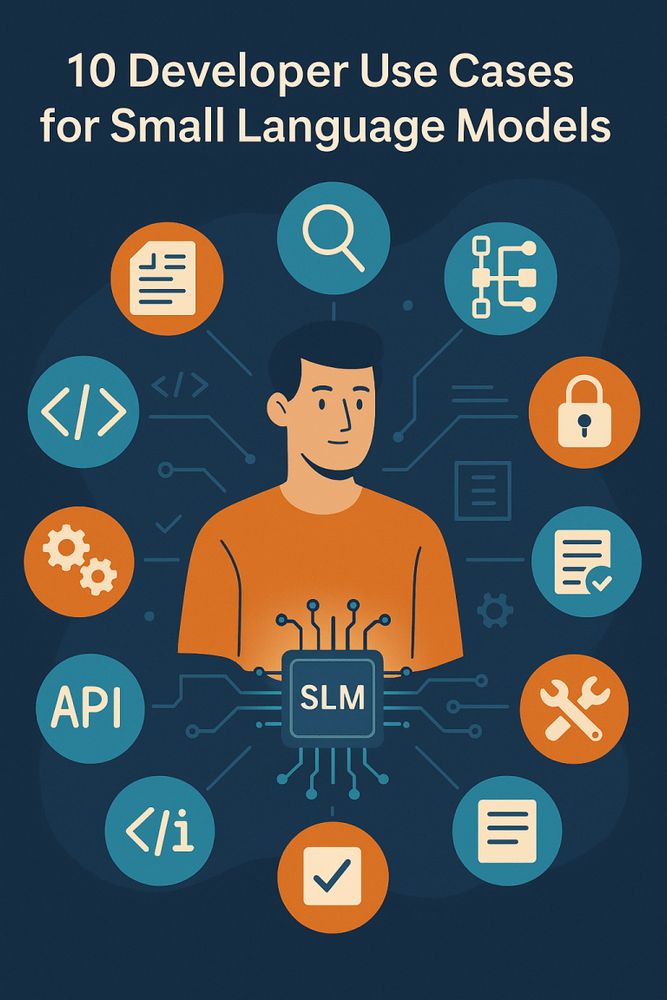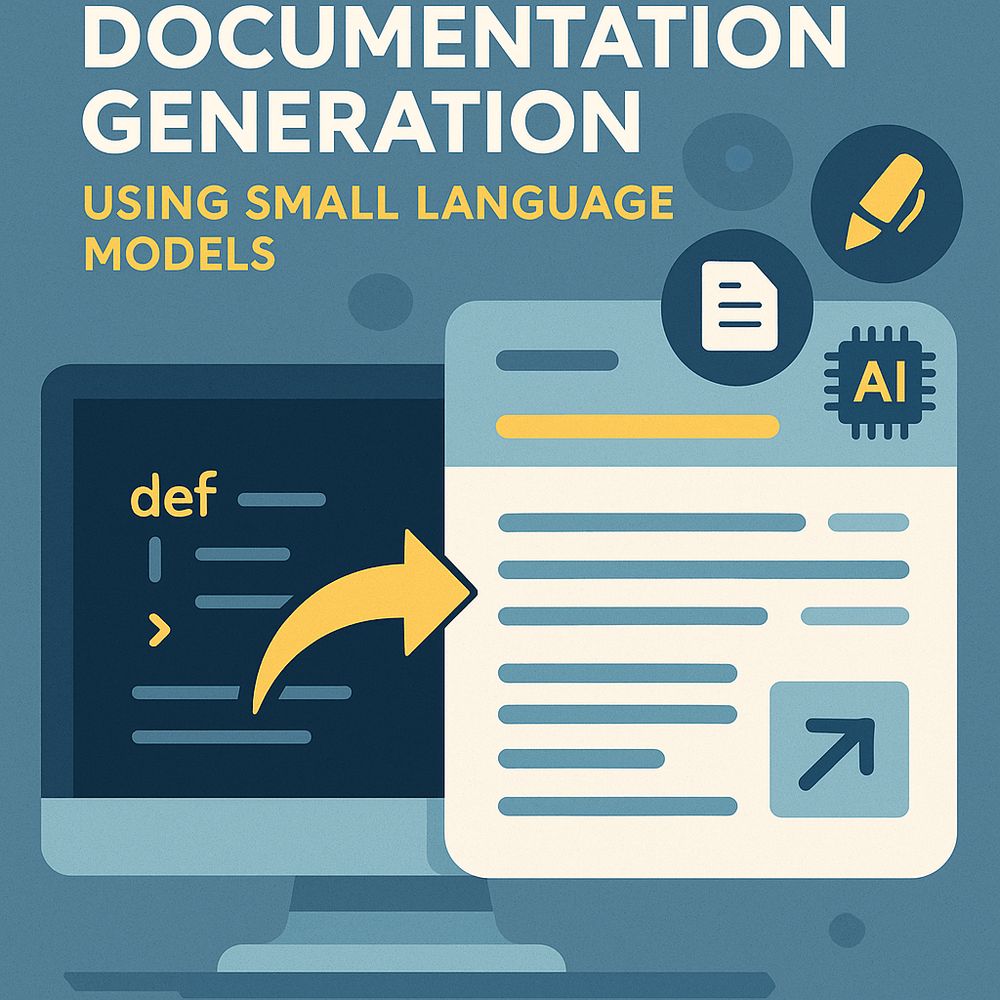
🔍 Agent workflows, DevOps, reasoning infra
🚀 Built on Azure AI Foundry + GitHub
📡 Real-time insights | Practical tutorials | Open infra thinking
🌐 O3AIStack.com
Small Language Models bring intelligence to DevOps pipelines — automating YAML generation, log analysis, and build validation locally. Discover how teams use compact AI models to accelerate Continuous Integration with full data…

Small Language Models bring intelligence to DevOps pipelines — automating YAML generation, log analysis, and build validation locally. Discover how teams use compact AI models to accelerate Continuous Integration with full data…
Discover 10 powerful use cases for Small Language Models in software development — from code generation to DevOps automation. Learn how compact, privacy-first AI models are transforming everyday…

Discover 10 powerful use cases for Small Language Models in software development — from code generation to DevOps automation. Learn how compact, privacy-first AI models are transforming everyday…
Small Language Models can detect vulnerabilities, explain security risks, and suggest fixes — all running locally. Learn how developers use compact AI models for safe, private, and intelligent code auditing.

Small Language Models can detect vulnerabilities, explain security risks, and suggest fixes — all running locally. Learn how developers use compact AI models for safe, private, and intelligent code auditing.
Small Language Models bring semantic understanding to code search — allowing developers to find functions by meaning, not keywords. Learn how local SLMs revolutionize code discovery with speed, privacy, and accuracy.

Small Language Models bring semantic understanding to code search — allowing developers to find functions by meaning, not keywords. Learn how local SLMs revolutionize code discovery with speed, privacy, and accuracy.
Small Language Models can translate code between languages like Python, JavaScript, or Java — safely, locally, and fast. Learn how SLMs enable cross-language development, refactoring, and migration workflows.

Small Language Models can translate code between languages like Python, JavaScript, or Java — safely, locally, and fast. Learn how SLMs enable cross-language development, refactoring, and migration workflows.
Small Language Models can generate and update documentation automatically — from docstrings to READMEs — all running locally. Discover how developers use SLMs to keep their codebases accurate, consistent, and well-documented.

Small Language Models can generate and update documentation automatically — from docstrings to READMEs — all running locally. Discover how developers use SLMs to keep their codebases accurate, consistent, and well-documented.
Small Language Models can automatically generate structured unit tests, boost coverage, and update test suites — all locally. Learn how SLMs are transforming the future of automated software testing.

Small Language Models can automatically generate structured unit tests, boost coverage, and update test suites — all locally. Learn how SLMs are transforming the future of automated software testing.
Small Language Models can automatically refactor and optimize codebases safely and locally. Learn how developers use compact AI models to reduce technical debt, enforce consistency, and modernize architecture.

Small Language Models can automatically refactor and optimize codebases safely and locally. Learn how developers use compact AI models to reduce technical debt, enforce consistency, and modernize architecture.
Small Language Models can automatically generate REST or GraphQL APIs — from routes to documentation — securely and locally. Discover how developers use lightweight AI models to build faster, safer backend systems.

Small Language Models can automatically generate REST or GraphQL APIs — from routes to documentation — securely and locally. Discover how developers use lightweight AI models to build faster, safer backend systems.
Small Language Models are transforming how developers review code. Learn how compact, private AI systems automate code checks, enforce standards, and deliver instant feedback — all within your local development environment.
Small Language Models are transforming how developers review code. Learn how compact, private AI systems automate code checks, enforce standards, and deliver instant feedback — all within your local development environment.
Small Language Models can automatically detect, explain, and fix coding errors locally — delivering faster, private, and cost-effective debugging. Discover how developers integrate these compact AI assistants into IDEs and…

Small Language Models can automatically detect, explain, and fix coding errors locally — delivering faster, private, and cost-effective debugging. Discover how developers integrate these compact AI assistants into IDEs and…
Small Language Models can generate professional-grade code efficiently, securely, and at low cost. Learn how developers and enterprises use compact transformers for automated refactoring, documentation, and test generation — all running…

Small Language Models can generate professional-grade code efficiently, securely, and at low cost. Learn how developers and enterprises use compact transformers for automated refactoring, documentation, and test generation — all running…
Pydantic and MCP servers form a powerful duo in modern AI architectures. Pydantic provides structured validation and schema enforcement, while MCP servers orchestrate multiple agents and modules. Together, they ensure your data flows securely and predictably…

Pydantic and MCP servers form a powerful duo in modern AI architectures. Pydantic provides structured validation and schema enforcement, while MCP servers orchestrate multiple agents and modules. Together, they ensure your data flows securely and predictably…
Learn how to set up Logfire tracing in your LLM apps—step by step. From installation to decorating your LLM calls, this guide helps you unlock real-time observability, performance metrics, and token insights with just a few lines of code.

Learn how to set up Logfire tracing in your LLM apps—step by step. From installation to decorating your LLM calls, this guide helps you unlock real-time observability, performance metrics, and token insights with just a few lines of code.
Just getting started with Logfire? This step-by-step guide walks you through installation, configuration, and your first log entry. It's the perfect starting point for developers building LLM apps or AI agents who want better visibility into…

Just getting started with Logfire? This step-by-step guide walks you through installation, configuration, and your first log entry. It's the perfect starting point for developers building LLM apps or AI agents who want better visibility into…
Wondering whether to choose o3‑pro, o3, or o4‑mini for your next AI project? This article breaks down the trade-offs between OpenAI’s latest models—speed, cost, and reasoning power—so you can pick the best model for your use case. Whether you’re prototyping…

Wondering whether to choose o3‑pro, o3, or o4‑mini for your next AI project? This article breaks down the trade-offs between OpenAI’s latest models—speed, cost, and reasoning power—so you can pick the best model for your use case. Whether you’re prototyping…
OpenAI’s o3‑pro model sets a new benchmark in reliability, reasoning, and tool-enabled AI—but with slower speeds and higher costs. Learn when and why to use this premium model in your AI agent stack.

OpenAI’s o3‑pro model sets a new benchmark in reliability, reasoning, and tool-enabled AI—but with slower speeds and higher costs. Learn when and why to use this premium model in your AI agent stack.
Building with LLMs? Don’t stay in the dark. Logfire is a lightweight observability toolkit that gives you full visibility into your AI agents, chatbots, and LLM-powered applications. Track prompts, monitor token usage, debug with trace-level detail, and…

Building with LLMs? Don’t stay in the dark. Logfire is a lightweight observability toolkit that gives you full visibility into your AI agents, chatbots, and LLM-powered applications. Track prompts, monitor token usage, debug with trace-level detail, and…
Make every form submission count. The Form Field Validation AI Agent uses smart rules and AI-driven corrections to ensure your data is clean, accurate, and compliant—before it hits your backend. From emails and dates to IDs and addresses, validation has…

Make every form submission count. The Form Field Validation AI Agent uses smart rules and AI-driven corrections to ensure your data is clean, accurate, and compliant—before it hits your backend. From emails and dates to IDs and addresses, validation has…
Modern AI agents don’t just generate text—they perform actions. Discover how Pydantic AI enables safe, structured function calling and tool integration, transforming language models into reliable operators in your…

Modern AI agents don’t just generate text—they perform actions. Discover how Pydantic AI enables safe, structured function calling and tool integration, transforming language models into reliable operators in your…
Scaling AI agents isn’t about adding more prompts—it’s about adding structure. Discover how Pydantic AI’s strong typing system helps you build safer, more scalable, and testable agents by eliminating guesswork and enforcing…

Scaling AI agents isn’t about adding more prompts—it’s about adding structure. Discover how Pydantic AI’s strong typing system helps you build safer, more scalable, and testable agents by eliminating guesswork and enforcing…
Want to scale your AI agents without reinventing the wheel every time? Learn how to create reusable, schema-first agent templates with Pydantic AI—so you can standardize, extend, and test your agents like real software components.

Want to scale your AI agents without reinventing the wheel every time? Learn how to create reusable, schema-first agent templates with Pydantic AI—so you can standardize, extend, and test your agents like real software components.
LangChain offers everything—including the overhead. Pydantic AI takes a cleaner, schema-first approach that prioritizes clarity, validation, and control. Learn how both tools differ—and why Pydantic AI may be the better fit for…

LangChain offers everything—including the overhead. Pydantic AI takes a cleaner, schema-first approach that prioritizes clarity, validation, and control. Learn how both tools differ—and why Pydantic AI may be the better fit for…
When LLM-based systems fail, debugging can become a nightmare. Pydantic AI brings structure, validation, and traceable errors to your AI agents—so you can catch problems early, fix them fast, and build reliable systems that scale.

When LLM-based systems fail, debugging can become a nightmare. Pydantic AI brings structure, validation, and traceable errors to your AI agents—so you can catch problems early, fix them fast, and build reliable systems that scale.

